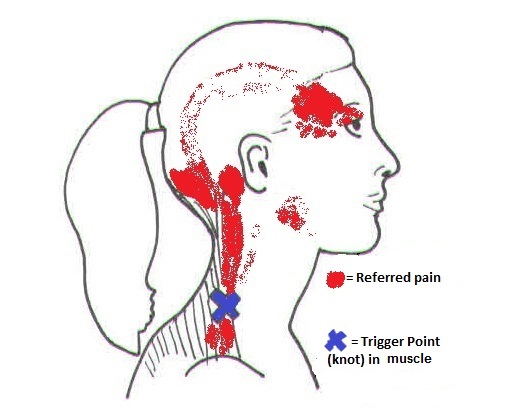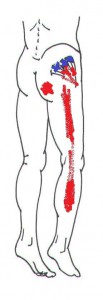Trigger Points & Trigger Point Dry Needling (Medical Acupuncture)
Call to book an appointmentWhat are Trigger Points?
A trigger point is essentially a tender, “knot” within a taut band of shortened muscle tissue. A common area for trigger points to occur is in the upper trapezius muscle in the top of your shoulder. This trigger point usually causes referred pain in the head and restricted movement of the neck (see Fig 1 below).
 Fig 1. Upper Trapezius Trigger Points causing tension headaches
Fig 1. Upper Trapezius Trigger Points causing tension headaches
Other trigger points can occur elsewhere in the body and often cause pain quite distant from the site of the trigger point. For example, the gluteus minimus muscle around the hip can cause pain all the way down the leg. This can be mistaken for, or co-exist with, “sciatic” pain from trapped nerves in the lower back (see fig 2 below).
 Fig 2. Trigger points in the deep gluteal muscles can cause referred pain similar to, and co-existing with, sciatica. Acupuncture needles at least 70mm long are usually needed for such deep muscle knots.
Fig 2. Trigger points in the deep gluteal muscles can cause referred pain similar to, and co-existing with, sciatica. Acupuncture needles at least 70mm long are usually needed for such deep muscle knots.
For a comprehensive list of trigger points and their pain referral patterns we recommend www.triggerpoints.net
So, what causes Trigger Points?
Trigger points are usually caused by some sort of stress on the muscle. This may be from a sudden overload due to a traumatic injury like a fall, a car accident or lifting something improperly. Alternatively it could occur over a long period of time due to prolonged low level tension within the muscle, which may be the result of poor posture, degenerative joints or emotional or metabolic stress.
There is on-going research about what’s actually happening, physiologically, within trigger points. We know that there is a continued release of certain neurotransmitters at the neuromuscular junction. Also, within trigger points there is continuous low level spontaneous electrical activity. This causes a self-sustaining contraction in that part of the muscle. Even if you consciously try to relax or stretch that part of the muscle, the knot simply won’t relax. Due to the muscle tension, there may be some decreased circulation which causes premature fatigue of the muscle at the trigger point, resulting in even more tension.
Can certain Medications or Massage help?
Some people are prescribed muscle relaxants, anti-inflammatory or pain killing medication. However this may not provide a complete solution as these medications generally mask the pain without addressing the underlying trigger points.
Some seek massage treatment or try to rely on stretching exercises, however only very specific stretching and deep tissue massage techniques will deactivate trigger points. If massage is performed in a way that flicks or glides over the knots, without the correct firm contact on the trigger points, this can irritate the over-sensitive nerve endings within them and ultimately lead to a worsening of the situation.
So what can be done about Trigger Points?
We treat trigger points as part of a complete therapy program. It is most important to identify and address any biomechanical and physiological factors that may be causing or perpetuating your problem. However during the initial stages of treatment the priority is to deactivate the trigger points in order to provide quick relief of your symptoms and to enable more efficient movement patterns needed for the later stages of your rehab which may involve corrective exercise and core stability training.
Trigger Point Soft Tissue Release (Trigger Point Massage)
Our therapists use specific soft tissue release techniques that involve very little or no oil and firm contact on the trigger points. The timing, direction and intensity of each massage stroke is very important in order to properly release the trigger points and this requires a precise knowledge of muscle anatomy.
Trigger Point Dry Needling
One of the best techniques for quick and long lasting trigger point deactivation is trigger point dry needling. Trigger point dry needling, sometimes referred to as medical acupuncture involves the inserting acupuncture needles into the taut muscle bands of trigger points in order to relieve pain and restricted range of motion.
Trigger Point Dry Needling and Traditional Chinese Acupuncture
Dry needling is not the same as traditional acupuncture. Traditional acupuncture is based on restoring flow of energy (“chi”) along meridians in the body. With trigger point dry needling there is no intention of affecting these energy meridians. Dry needling is based on modern Western science and our knowledge of anatomy and physiology.
Trigger Point Injections and Trigger Point Dry Needling
Injections for trigger points are used by some doctors in hospital pain management departments. This involves using a hypodermic needle to inject a various medication such as local anaesthetic, cortico-steroid or Botox into the point. With dry needling, there is no substance or medication injected. It has been found in research studies that people improve when needles are inserted into trigger points, no matter what substance is injected, or even if nothing is injected. Therefore, it is often the effect of the needle that helps, not the medication injected.
Dry needling offers some advantages over injections. Firstly, because no medication is involved it is a lot cheaper to perform. Secondly, several taut muscle fibres within a trigger point can be released with an acupuncture needle by re-applying the needle at slightly different angles in order to release even more tension (see fig. 2). Thirdly, whilst injections such as Botox can tackle the excessive neurotransmitter release at the neuro-muscular junction, injections may not tackle the spontaneous electrical activity within trigger points as well as dry needling, especially when this is performed with care and precision with the re-angulation method.
What happens during and after a Trigger Point Dry Needling session?
Dry needling is a lot less uncomfortable than injection needles. You may find that the needling is less uncomfortable than some of the usual manual soft tissue techniques. The (acupuncture) needle used during dry needling needles is very small in diameter, 0.2 to 0.5 mm thick and they do not have a serrated or cutting edge like injection needles.
You may feel nothing at all when the needle goes in, or you may feel a slight stinging sensation. The therapist will insert the needle into the muscle where the trigger point is, using their palpation skills to locate the precise area of tension. When the needle makes contact with this relevant part(s) of the Trigger Point (see Fig 2), it should cause a twitch response. The twitch response is a small contraction of the muscle. It may just be a mild twitch, or it may feel like a “cramping” of the muscle. Sometimes it feels like a deep ache, or perhaps a burning sensation. After the twitch, the muscle “lets go”. It is important that the twitch response is experienced, otherwise dry needling is less likely to be successful as full release of the trigger point is unlikely to be achieved. You may receive needling to several different areas during the session. You might experience referred pain in a distant area of your body. It’s a good thing if you do experience referred symptoms, especially if it’s a “familiar” pain for you. This means that we’ve needled an active trigger point which is causing some of your symptoms. Any discomfort is usually fairly short.
As well as the needling, we may do other manual therapy procedures before or after. You might be instructed on exercises to do at home to help continue the effect of the needling.
It’s normal to feel some soreness for a day or two after needling. It’s usually helpful to apply some heat to the area later in the day (heating pad or hot bath), in addition to doing the stretches and other exercise.
How does Trigger Point Dry Needling work?
After the needling and the twitch response, spontaneous electrical activity within the trigger point is reduced. Also, although the needles are all sterilised, needling causes an immune and inflammatory response resulting in increased blood flow and healing. The end result is that the muscle lets go of its self perpetuating contraction. With the decrease in muscle contraction, there is an additional increase in blood flow. Needling also stimulates the body to release growth factors and natural pain-killing like chemicals which further promote long term healing.
How many Sessions of Needling am I likely to need?
The number of needling sessions necessary depends on the how severe the problem is and how long it has been present. Acute problems that have lasted a month or less can usually be resolved with one to three sessions, whilst problems that have been present for many months or years will typically need an initial course of 10 to 20 sessions to fully resolve symptoms. Infrequent on-going maintenance sessions may be needed to prevent the old trigger points becoming active again.
Is needling safe?
Although there are sine potential risks, for which we take every precaution to minimise, dry needling is generally regarded as a safe procedure. The most serious complication which could occur is a puncture of the lung (pneumothorax). If this happened, it may only require a chest x-ray and no further treatment. Symptoms of shortness of breath may last for several days or weeks. A more severe lung puncture may require hospitalization and re-inflation of the lung. This is a rare complication and in skilled hands should not be a concern.
Other risks include excessive bleeding (causing a bruise). Bruising is a common occurrence and should not be a concern unless you are taking a blood thinner. Though the needles are sterile, there is always some risk of infection. The needles used for dry needling are very small and do not have a cutting edge, therefore the likelihood of any significant tissue trauma is small. With our extensive knowledge of anatomy, we will avoid major nerves and blood vessels.
